|
This article from the July
1973 issue of American Aircraft Modeler magazine will be of great
interest to the modern e-power modeler who wants to get a feel for what the
early pioneers in electric powered aircraft we doing to forge the trail to
today's highly powerful, brushless, outrunner motors that use
microprocessor-controlled electronic speed controls (ESCs). Lithium-Polymer
(Li-Po) and lithium ion (Li-Ion) batteries have almost completely replaced the
nickel cadmium (NiCad) and nickel-metal hydride (NiMH) batteries back in the
day. American Aircraft Modeler
ceased publication in March of 1975, and is no longer in print by the copyright
owner, the Academy of Model Aeronautics (AMA). See Brian L.'s vintage
Mattel Super
Star model.
Cordless Electric Flight Motors
Review by Bob Meuser
Flip the switch, and it is up, up the long delirious burning blue, with safe,
silent, inexpensive, non-polluting electric propulsion. Gone forever are the greasy
kid stuff and barked knuckles associated with the balky glow engine, the impetuous
variability of Pirelli rubber, and the mad running through sand and muck to launch
a towline glider. Just flip the switch.
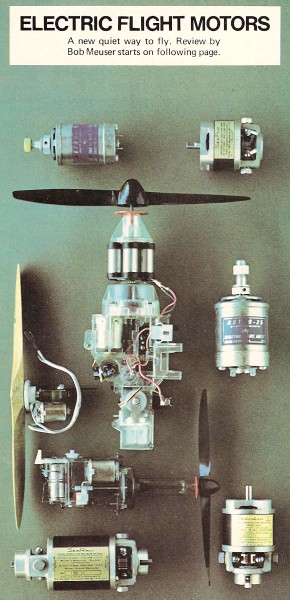
Still no one knows what type of model will be ideal for electric
flight. A power pod for use on a semi-free flight design with two- or three-channel
radios is Quite desirable and the UREI EMF-040, shown here, is to be packaged with
this In mind. Timer charging jack and switch are included in the pod.
Well, not quite. We shouldn't get too self-righteous about pollution until we
examine what comes out of the stack down at the battery works. The inconvenience
of greasy kid stuff and balky engines must be weighed against an assemblage of motorcycle
batteries, charging cords, meters and the like, although electric propulsion probably
has the edge. It can be as inexpensive as a cheapie Half-A. It can also be the most
effective money sponge devised by the mind of man if it goes the route of electric-propelled
boats in England; there it took the shooting off of $132 worth of short-lived silver-zinc
batteries to win the National Speed Finals. It is as safe as a cordless electric
toothbrush if the manufacturers' instructions are followed, but before going off
on your own, take a good look at a tree-the next one you "see" might be in Braille.
And, at best, an electric airplane will not go up the long delirious burning blue
very fast, for the best electric propulsion system cannot compete with a mill-run
glow engine on a pounds-per-horsepower basis.
Nevertheless, the power can be quite satisfactory for many purposes, and in its
simplest form, electric propulsion is as convenient as a doorknob, and as quiet
as a clam with laryngitis. The latter is especially important nowadays when RC types,
Ukie-jocks, and Free Flighters alike are struggling to find and hold flying sites.
It certainly offers a whole new set of enticing challenges, and it deserves the
close scrutiny of every serious modeler interested in a bit more than placing Foot
L ahead of Foot R along Beaten Path.
There is now on the market a diverse selection of electric motors, batteries,
and complete propulsion systems either specifically intended for model aircraft
propulsion or readily adapted to it. In addition, there is a phantasmagoria of untried
but potentially useful paraphernalia sufficient to keep anyone with a dash of Tom
Swift or J.L. Seagull in him happily frustrated for a lifetime. This article covers
the complete propulsion systems that are available-motor and battery combinations,
plus auxiliaries. The table shows the prices and specifications of all of the power
units as completely and as accurately as we were able to. It was not possible to
make the power ratings consistent, however, as some are based on manufacturer's
specifications, some are peak ratings from bench tests-in-flight power would be
much less-and some are estimated, rather carefully however, from the manufacturer's
statement of the performance of the aircraft. The power ratings should be used only
as a rough guide, certainly not as an indicator of what you are getting for your
money. The power output of any motor can be boosted simply by applying more voltage,
or loading with a larger prop, but its life will be greatly shortened.
The aircraft sizes listed are rough guides only. A power glider, where the purpose
of the motor is to get the model up to soaring altitude, would have several times
the wingspan of a stunt model using the same motor. Duration of powered flight also
varies depending on the flight profile-if the model is climbing the whole time,
the duration will be shorter than if the model is stunting. In a dive, the motor
is acting partially as a generator, and the battery drain is very small.
Interested in silent flight? Here's a review of what is available
in power systems at this time. The variety is interesting- the performance is good.
/ by Bob Meuser
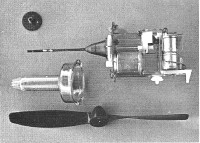
Mattel Super Star
free flight model is very popular with all modelers. It really performs. Power unit
is separately available from Mattel and adaptable to many homemade designs.

Power unit in Mattel's RC Signal Command is bigger and heavier,
but very strong and even self-contains a magnetic actuator and its battery. A cut-down
version could power a two-channel RC glider.

 From Germany comes the Graupner Electro-Prop
with its unique folding pusher prop-and it's a geared unit. Battery charger available
with it operates from your car battery and is a quick-charge system. From Germany comes the Graupner Electro-Prop
with its unique folding pusher prop-and it's a geared unit. Battery charger available
with it operates from your car battery and is a quick-charge system.
Enter Mattel: The cordless electric airplane has been around since the early
fifties, but until quite recently it could scarcely be considered a viable alternative
to rubber-powered and gas-powered models. With the advent of the high-rate fast-charge
nickel cadmium battery, and the deluge of cordless electric products that followed
in its wake-drills, chain saws, lawn mowers, toothbrushes, carving knives, and a
host of others-the practical cordless electric airplane became virtually an invention
that was waiting for a place to happen. And when it happened, it happened all over
the place! Most of the propulsion systems on our list were either on the market
or under development before the Mattel Super Star hit the market. But the Super
Star is certainly the most apparent manifestation of electric propulsion, and it
is of course a complete aircraft, not merely a propulsion system.
Picture yourself, an experienced modeler perhaps, as the president of a large
toy manufacturing company. A fire-eyed tousle-haired Idea Man comes in with the
Big One for the week. "We take a battery and an electric motor, see?"-with half
the power-to-weight ratio of even a rubber-band motor. "And, a foam wing and vacuum-formed
plastic fuselage."-with half the strength-to-weight ratio of proper stick-and-tissue
construction. "We hold it all together with no-lickum stickum labels, and it will
fly right 'out of the box' with almost no adjustment." You cough and fidget a bit.
"It will be so simple that even an adult can fly one." You dear your throat to suppress
a giggle. "And it'll be tough enough to survive the crash that will result when
some lad's father decides he is smarter than the instruction book." The giggle makes
it. "And, we'll retail it for less than $15." You laugh him half, way into next
Thursday.
Mattel must be laughing all the way to the bank. Obviously not -the brain child
of 'our mythical idea man, but rather a product of careful, skillful engineering
and ingenuity, the Super star flies almost too well, as some skeptics discovered
by losing theirs on the maiden voyage. The audacity of a bloomin' toy-monger duplicating
or surpassing some of our own best efforts with a chunk of plastic!
The Super Star became a glint if Mattel's corporate eye about five years ago
when the quick-recharge NiCads first appeared, and during the early chapters in
the life of the Sizzler car. It also came to pass that half-way 'round the world,
in the Land of the Rising Sun, the quick-recharge NiCad had 'not escaped the attention
of a model aviation enthusiast by the name of Ken-ichi Mabuch, who by a curious
coincidence happened to be the president of the world's largest manufacturer of
small electric motors. Both the Mabuchi and Mattel companies had progressed quite
far with electric aircraft development before they discovered each other's interest;
when they did, the Mabuchi-powered Mattel Super Star, and later the Signal Command,
were the inevitable results.
The Super Star: At the bottom of the list in both cost and performance,
but perhaps at the top of the totem pole in fun-per-buck ratio, is the Mattel Super
Star power plant. The motor is a big step up from many of the Mabuchi toy motors
found in surplus stores and elsewhere in that it has carbon brushes in place of
-the usual phosphor bronze sheet metal or wire ones. The battery is a pair of 100
mAh General Electric 1/3-AA-size NiCads-the same cells used in the Sizzler cars.
Extensions of the brush arms serve as connections to the battery, charging cord
receptacle, and switch.
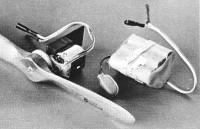
Galler Industries takes a special wound slot-car type motor,
gears it, and drives a 10-6 wood prop from a fairly small battery pack. It is a
lightweight system and not complicated. Several accessories are available to operate
the unit with RC or a timer.
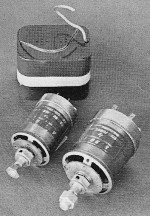
From Astra Flite comes this neat reworked high-performance motor
for direct driving standard gas engine type props. Two sizes, smaller unit produces
1/10th hp at peak of battery charge-quite powerful! Larger motor gives 1/4th hp!
The 7-1/4-in. dia., 5-in. pitch prop is driven through plastic gears having a
ratio of 5.33. The motor, gears, battery, and flight-program-cam drive are integrated
into an ingeniously contrived plastic housing that would make a Chinese block-puzzle
designer writhe in envy. The complete power unit is available from Mattel for $7.50
as a replacement part. The charging cord and prop are not included, however, so
at $10 to $15 for the complete aircraft, the Super Star is the biggest bargain in
town.
Now there is a new Super Star in the sky, with 15% more power, a general beefing
up of the weaker spots, a very slight increase in cost, and identified by its yellowish
carton. About 112% of the earlier prop shafts failed prematurely, so Mattel adopted
an alloy steel shaft heat treated for maximum toughness. Perhaps that is the sort
of attention to detail that helped make Mattel the country's leading toy manufacturer.
The most distinguishable features of the new Super Star are a man that parachutes
to earth and streamers that unfurl in towed-sign fashion, actuated by the already
somewhat ludicrous flight programmer. Personally, I'll take plain vanilla-a model
that takes off the ground, circles realistically, and glides in for a fair landing
is enough to expect of a toy airplane. Clearly, unfurling streamers and parachuting
dolls befit only mere toys and are scarcely worthy of notice by "serious" model
hobbyists. Still, if the same system were used to retract the landing gear, then
lower it, along with the flaps ...
There is no need to chuck your old Super Star power plants or to delay buying
one if the new model is not available. The increased power is obtained by loading
the motor more heavily by virtue of a lower numerical gear ratio. The battery is
the same, so the flight duration is decreased slightly. The same result could be
obtained by loading the motor with a prop of higher pitch, greater diameter, or
greater blade area. To a rubber-power nut this must seem backwards-more power and
less motor run with a larger prop - but that is the way it works.
The next step is a big one, as there are no power plants between the $7.50 Super
Star unit and ones costing six times that amount.
The Alpha Power Unit: The heart of the Alpha is a specially rewound
and reworked 26D-size can-type slot-car motor, fitted with two ball bearings. The
output countershaft turns in sintered bronze bearings and is coupled to the motor
by a steel pinion driving a nylon gear, with a ratio of 5.78. The stock 10x6 wooden
prop is cemented directly to the output gear. The assembly consisting of the prop,
shaft, and gear sells for $3.50 and is easily replaced. The battery consists of
five 500 mAh AA-size cells made by General Electric. The motor is provided with
a shock-absorbing Lexan tab for mounting it to the fuselage. The complete motor-battery
system, selling for $45.50, includes a cord for overnight charging from a car battery.
A fast-charging cord, which includes a high-wattage current-limiting resistor, is
available at extra cost.
Two accessories are of interest to the purchasers 'of either the Alpha or other
electric propulsion system of comparable power. The Solid State Timer ($14.95),
weighing an ounce, turns off the motor after a period that is adjust-able from 30
see, to four min. The one-oz. Mocontrol ($12.95) which may be used with any RC system,
provides in-flight on-off control of the motor without requiring an additional RC
channel. A small permanent magnet is mounted to any moving part of the rudder control
system. The Mocontrol sensor is mounted in the aircraft close to the magnet. A quick
blip of full left rudder turns the motor off; a right blip restores full power.
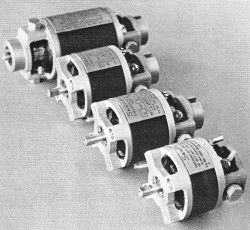
The engines from Kraker are specially designed throughout for
model application and hold several world electric power boat records. The small
Sea Pup is suitable for aircraft use as shown here with a 7-4 prop. A disassembled
Sea Pup shows what is involved inside.
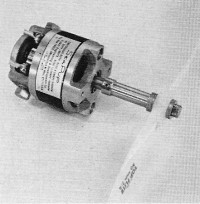
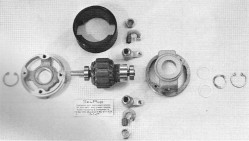
The Signal Command: On the next rung of the cost-power ladder, the Signal
Command power unit looks like a Super Star that has been popping Big Pills. The
housing and gearing configurations bear a family resemblance. The battery, a cylindrical
cluster of six G.E.250mAh 1/2AA-size cells, slips over the prop shaft housing. Two
1/3-AA cells to drive the radio, and the galloping ghost actuator, are built into
the power unit housing. The 9 x 7 prop, driven through a 5-to-1 gear reduction from
the 1/50-hp motor, adequately powers the four-ft. 25-oz. Signal Command aircraft.
The motor has a three-slot armature, carbon brushes, and is similar in design to
that in the Super Star. A three-position switch lever projects from the bottom.
The back position is off. The middle position fires up the radio gear and allows
the motor to run once it is started. The forward position starts the motor, and
after the lever is released it flips back to the run position. The prop thrust pulls
the prop shaft forward actuating a switch and keeping the motor running. Should
the prop tangle with the weeds or the model nose over, the prop shaft slides back
and turns the motor off, preventing a burnout. Should that fail, an easily replaced
automotive type fuse blows. The thrust-actuated switch serves another function:
When the battery starts running out of beans, the circuit is broken, preventing
the battery from discharging completely, which could cause reverse charging of the
weakest cell.
The Signal Command is no longer in production. Mattel's policy is to carry spare
parts in stock for a number of years beyond production, so the power unit will continue
to be available as a spare part.
The EMF-040: The most recent propulsion system on the scene, and an
exceptionally complete one, is the ElectroMotive Flight system by United Recording
Electronic Industries. The Power Module is a streamlined pod containing the motor,
reduction gearing, charging cord receptacle, switch, a low-voltage cut-off device
to prevent charge reversal, a free-wheeling device, and a radio interference suppression
system. An optional sold-state timer, weighing 0.65 oz., and adjustable for motor
run times of from one to five min. may also be installed within the pod. The rear
portion of the pod may be removed to facilitate fuselage mounting.
The Field Charging Unit is provided for charging the NiCad batteries from a 12V
car or cycle battery. This is not simply a line cord and current-limiting resistor.
It includes a battery-temperature sensor and a control circuit that decreases the
charging current as the fully-charged condition is approached, a solid-state timer
to permit unattended operation, and a meter to indicate any anomalies in the system.
Two alternative battery packs are offered. The smaller one weighs 3.6 oz., contains
six 250 mAh 1/2AA-size NiCads, and drives the motor to 1/40 hp for a motor run of
three to five min. The larger pack weighs 5.3 oz., contains seven 450mAh AA-size
NiCads, and drives the motor to 1/25 hp for a motor run of 3-1/2 to 5-1/2 min. Motor
run is roughly 1/2 to 2/3 of the charging time.
Props of 7, 8, and 9-in. dia. are offered. They are high-pitch, wide-blade, square-tip
props about midway between typical gas engine and rubber-driven designs. As if this
were not enough, an optional pulse-width-modulated throttle control is available.
A kit for an RC trainer, the Electric I, is offered. Designed by Freddie Reese and
Don Dombrowski, it spans 52 in. and weighs 17 to 22 oz., depending on the battery
pack and radio system used. The motor is similar to a slot-car motor in configuration,
but it is designed to produce high power at relatively low rpm. The motor efficiency
(56%) and power-to-weight ratio (1/4.4 hp/lb.) are exceptionally high for such a
small unit, especially when one considers that the weight is that of the entire
power pod, not merely the bare motor.
Website visitor Brian L. contacted me about finding replacement
batteries for his vintage Mattel Super Star electric R/C model. He sent me photos
of his model and the power drive system from the airplane.
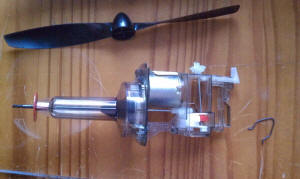
Mattel Super Star power system.
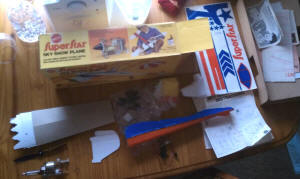
1970s era Mattel Super Star kit.
I definitely recommend against charging the batteries with anything
other than a charger designed to control the current supply. Using a 6V lantern
battery wasn't a good idea then or now. Aside from possibly causing a fire, improper
charging can ruin the cell's capacity to hold a charge.
The specifications quoted above are based on tests of pre-production prototypes
performed by the manufacturer. At this writing the system is not yet in production
and prices have not been established.
The Graupner Hi-Fly: Johannes Graupner of Germany, one of the oldest
names in commercial electric propulsion, has recently introduced a new electric
propulsion system as an alternate power plant for its Hi-Fly aircraft. The Hi-Fly
is basically a high-performance RC glider, spanning 90 in. and weighing two lb.
Two propulsion systems are offered: An over-the-wing pod housing a Cox Golden
Bee or a Cox TD 051, and the Electroprop system. The Electroprop system consists
of two motors, one on the trailing edge of each wing, driving 14-in. folding pusher
props. The 12-volt motors are driven in parallel by two G-volt Varta NiCad batteries
in series. The total weight of the propulsion system is two lb., doubling the flying
weight of the aircraft. The power output of each motor, inferred from the published
data on the aircraft performance, is about 1/45 hp, giving the aircraft an average
rate of climb of 180 ft,/ min. for the first three min. of the ten-min. power run.
The design philosophy follows that applied by Graupner engineer Fred Militky
to the earlier Silencer and Silentius aircraft: A high gear ratio to permit the
use of a large, high-pitch, rubber-power type prop capable of very high efficiency
at low aircraft speeds. The motors are not the Micro-Mo motors employed in the earlier
aircraft, but are much more powerful ones of conventional design, employing five-slot
armatures and internal brushes. Motors, motor mounts, props, batteries and various
accessories are available separately or as a complete package. An ungeared version
of the motor is also offered, primarily for model boats. The geared motors would
be unsuitable for any aircraft that is not quite similar to the Hi-Fly. As they
require 12 volts, two battery packs would be required even for one motor. The power-to-weight
ratio would then be too low for anything but a super-efficient, super-light aircraft,
but the motor run would be extended to 20 min. The high gear ratio requires that
a large prop be used-too large for conveniently mounting the motor to the nose of
the fuselage, and also too large for a pylon mount. For the intended application,
however, the system seems well suited.
The Electroprop system is expected to be available in the U.S. in September or
October, and will be sold through normal hobby supply channels. U.S. prices have
not been announced.
The Astro 10 and Astra 25: The Astra 10 and 25 motors are specially
modified high-quality industrial motors. End bells are ventilated to provide air
cooling. The prop is bolted directly to an extension of the armature shaft. The
brushes are cantilever-arm mounted. The five-and seven-slot armatures turn on precision
ball bearings at the front and sintered bearings at the rear. The Astra 10 battery
contains 12 550 mAh 1/2-sub-C cells. Two 10-volt batteries connected in series drive
the Astra 25, and two sizes are available: 550 mAh, eight 1/2-sub-C cells; 1200mAh,
eight sub-C cells. Batteries are enclosed in a light plastic container. The Astra
10 battery is charged from three 6-volt motorcycle batteries in series. Astra 25
batteries are charged in parallel from a 12-volt battery.
A prototype of the Astra 25-25% larger than the production model, and driven
by a one-shot Eagle-Pincher silver-zinc battery-was used by Roland Boucher in the
Fournier RF-4 that he flew for 30 min. at an average speed of 40 mph. With stock
NiCad batteries flights up to eight min. are obtained. Recently the Boucher brothers
and their associates have been flying their Electro-Sport-10 aircraft with the Astra
10 motor. This is a simple sheet-covered model with an all-up weight of 38 oz. and
controlled by a Kraft two-channel "brick." Span is 42 in., but spans from 36 to
44 in. have been tried. They now have a "throttle" control that gives a realistic
600 rpm idle. Aircraft companies have used the Astra motors to power RC models of
various sorts, including a model of an STOL aircraft, some being multi-engine applications.

Drawings by Bob Meuser
The Kroker Systems: The Kraker motors-Sea Ram, Sea Wasp. etc.-are generally
regarded as the world's best model boat motors. Most world records have been set
with Kraker-powered boats, and at the last European Championships, the winning English
team used Sea Wasp 12 motors. The requirements for aircraft propulsion are essentially
the same as those for boat propulsion: high power/weight ratio, high efficiency,
high reliability, and long life. While the 3/8 hp Sea Ram is a bit large for aircraft,
the 1/10 hp Sea Pup was specifically designed with aircraft propulsion in mind .
The 12-slot armature, which is more expensive to manufacture. than one with fewer
slots (or poles, if you prefer). turns on two sealed precision ball bearings supported
in rigid aluminum end castings. The shunted, cartridge-mounted silver-impregnated
brushes turn against a 12-bar silver-copper alloy commutator (24-bar on the Sea
Wasp 12.) The result is a military quality commutator that can pass a 30,000 rpm
spin test at 5000F and still satisfy a run-out specification of 0.0005 in. Aircraft
prop adapters are available, as are batteries containing imported SAFT NiCad cells.
Brush timing can easily be set by the user for either clockwise or counter-clockwise
rotation. The Kraker motors are obviously designed for long trouble-free operation,
in addition to their high power-to-weight ratio and high efficiency.
Batteries: For most model aircraft propulsion applications, the only
batteries worth considering contain nickel-cadmium cells of the sealed cylindrical
type (not the button type) having sintered plate construction. Most of these are
equipped with a safety valve to pre-vent the cell from exploding due to the generation
of excess gas. While such cells have a safety valve or "vent," they are not termed
"vented" batteries; that term is reserved for the NiCad batteries that are built
like car batteries with liquid electrolyte sloshing around.
Cylindrical NiCads are made by a number of manufacturers: Gulton, Gould, Marathon,
Union Carbide (Eveready), and General Electric in the U.S., SAFT in France (distributed
in the U.S. exclusively by Kraker Engineering), Varta in Germany, and probably many
others.
Some cells, by virtue of their inherent size and shape, and because of the way
the connections are made inside, can be discharged very rapidly without a severe
voltage drop, and without a great loss in capacity. Usually the smaller cells are
better at this, as there is simply a shorter distance for the current and heat to
travel. When it comes to cranking out a moderate amount of power for a long time,
the larger cells have the edge - a higher energy for their weight. However, there
are exceptions. In the smaller sizes of cells, all cells cost about the same, regardless
of size; in the larger cells, cost is roughly proportional to capacity.
The normal charge rate for most NiCads is that which charges the battery to full
capacity in about 14 hours. The charging current, in amperes, is one-tenth of the
nominal capacity in ampere-hours. A 500 mAh (milliampere-hour) battery would be
charged at a constant current of 50 mA (milliamperes). At that charge rate, batteries
can be overcharged for a hundred hours or so without damage. Some quick-charge cells
can be charged in four hours and similarly left on overcharge without damage. For
our purpose much faster charging is required. Once a cell becomes fully charged,
all of the additional energy pumped into the cell goes into the generation of heat
and gas. Up to a certain point, the gas is absorbed chemically within the cell.
Beyond that point, the gas is vented, and some of the capacity of the cell is permanently
lost. The difference between a high-charge-rate cell and a normal-charge-rate cell
is not so much that the high-charge-rate cell can be charged faster, but that it
Can be overcharged at a high rate without damage.
Several manufacturers have developed systems for fully charging their batteries
in 15 to 30 min. A new line of Eveready "Hustler" cells, for example, has been designed
to exhibit a sharp temperature rise before the pressure rises to the point where
venting occurs, and the charging is terminated when the temperature reaches a certain
value. SAFT, on the other hand, utilizes the sudden and reproducible voltage rise
that occurs with their cells to signal the end of the rapid-charge period. These
are just two examples, and you can be sure that the other manufacturers who do not
yet have such rapid-charge systems are working hard at developing them.
That still is not fast enough for a kid with the fidgets, but anything faster
inevitably results in either a ruined battery, or an incomplete charge. One manufacturer
of cells specifically intended for fast charging, for example, states that 25% of
the capacity can be obtained with a one-min. charge, 45% with a three-min. charge,
and 70% with a five-min. charge. The method used is the "dump-timed-charged" method.
The cells are first "dumped," that is, completely discharged, or nearly so. Then
one applies a "timed charge"-a certain current for a certain length of time-to a
fraction of their capacity that is sufficiently far removed from a full charge to
ensure that the cells wilt not be accidentally overcharged at a high rate.
A high-rate NiCad cell can be completely discharged hundreds of times. But, a
battery consisting of more than about two cells connected in series cannot be completely
discharged without suffering irreversible damage. No two cells are identical, so
in a series string of cells, one cell is certain to be weaker than the others.
When the battery is discharged, the weakest cell will become completely discharged,
while the others continue to produce current. That current flows through all of
the cells, including the weak one. The current is in the direction opposite to that
in which a cell should be charged, so the weak cell becomes charged in reverse.
At best, the cell will lose a little of its capacity. At worst, the cell will become
completely incapable of being charged in the proper direction.
In a multi-cell battery, then, it is best to terminate the discharge before the
battery voltage drops too low. Prior to charging by the dump-timed-charge method,
it is best to discharge the battery cell by cell, or to occasionally give the battery
a long slow charge to be certain all cells are fully and equally charged.
Conclusion: the power outputs of electric propulsion systems seem low
compared to those for glow engines. But it is not the power output of the motor
that counts, but rather the power output of the prop. Tests have shown that a small
geared electric motor puts out the same propulsive power at 27 mph as a reed-valve
049 engine having twice the horsepower. If the glow engine were geared down about
3-to-1 the story would be different, of course. Small motors turning at high rpm
used in models that fly slowly must be geared down to achieve a reasonably high
propeller efficiency. For motors as large as the Astro and Kroker motors, which
turn at lower rpm than their smaller .counterparts, and in models that fly fast,
little can be gained by gearing down the prop.
Since we started gathering material for this article, several propulsion systems
we were initially not aware of have popped up, and there is a possibility that there
are still some that we missed. AAM apologizes for any that have been omitted, and
will update this review as new systems appear. AAM is under-taking tests of a typical
RC airplane to determine the relative performance with both electric propulsion
and gas-engine propulsion in terms of both laboratory and field tests, and will
report on the results.
In a future article we will consider the application of electric propulsion to
various types of models. We'll consider types of batteries other than NiCads. We'll
show you how to match the propeller, batteries, gears, prop, motor, and aircraft
to each other-not too formidable a job when it is laid out step by step. And, we'll
discuss some motors that are not specifically intended for model aircraft propulsion,
but which are nevertheless worth considering.
Gas motors specifically designed for model aircraft propulsion were commercially
available near the turn of the century, but it was thirty years before the gas engine
had any noticeable effect on sport or competition model aviation . Then the gas
engine suddenly took over, practically to the exclusion of other forms of propulsion.
Commercially available electric propulsion systems were on the market 14 years ago,
but it has only been within the last year that electric propulsion has been more
than an interesting curiosity. Rather suddenly, interest has bloomed, and new systems
seem to pop up every few months. Where will it all lead? Who can say. Ten years
from now will we look back on electric propulsion as the Hoola Hoop of Model Aviation?
Or as we are topping-up our NiCads, will we reminisce about the good old days when
we used to fly those noisy, balky, dirty old glow engines?
(1) Specifications are for one power unit and one battery. Two of each are required.
(2) Based on 1.2 volts per cell except for Kraker motors which are manufacturer's
ratings on motors.
(3) Tentative rating for aircraft propulsion.
(4) For 1.2 Ah SAFT batteries having 9. 8. and 12 cells. respectively. Batteries
of 1.8 Ah and 4 All capacity are also available with corresponding increases in
weight and flight duration.
(5) Author's tests at nominal voltage. Average in-flight power will be less,
especially for systems with short duration.
(6) Per motor, estimated from manufacturer's aircraft performance data. Average
during first 3 min. at flight. All other performance data is based on Information
supplied by the manufacturer.
(7) Aircraft supplied with System. Other aircraft sizes are from manufacturer's
recommendations or are author's estimates. Subject to wide variation, depending
on type of performance desired.
Addresses:
Mattel, Inc.
P.O. Box 2350 Hollywood, Calif. 90028
Kroker Engineering and Dev. Co.
P.O. Box 14056 Albuquerque, N. Mex. 87111
Galler Electronic Industries
P.O. Box 87 So. Walpole, Mass. 02081
United Recording Electronics Industries
11922 Valerio St. North Hollywood, Calif. 91605
Astro Flight, Inc.
2301 Cheryl PI. Los Angeles, Calif. 90049
Johannes Graupner
7312 KirchheimjTeck Postfach 48jGermany
SAFT batteries
(See Kraker above)
Many thanks to the Academy of Model Aeronautics for permitting the reprint of
this invaluable article from the July 1973 edition of American Aircraft Modeler
Articles About Engines and Motors for Model Airplanes, Boats, and Cars:
|


